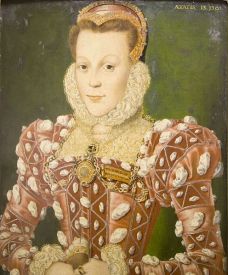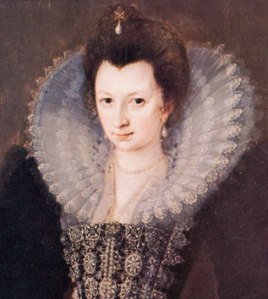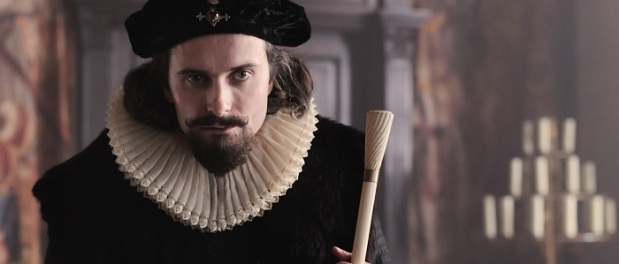Southampton and the Tudor Rose Theory (Part 2 of 2)
In the Prince Tudor theory, Elizabeth I was only the Virgin Queen figuratively not literally.
It is rumored that during one of her royal progresses, particularly the one she took in August of 1572, she was intimately involved with the 17th Earl of Oxford, Edward de Vere. He was, after all, the Queen’s favorite courtier at that point in time. In a letter written at that time by Gilbert Talbot to his father the Earl of Shrewsbury, the queen “delighteth more in [Oxford’s] personage and his dancing and his valiantness than any other” (Brougham 171).
In a nutshell, the Prince Tudor/Tudor Rose theory suggests that Elizabeth and Oxford had a son. He was placed in the Southampton household as the “Changeling Boy,” Henry Wriothesley, who eventually became the 3rd Earl of Southampton (Whittemore xxxviii).
As previously stated, William Cecil, Lord Burghley, had been pressuring Wriothesley to marry his granddaughter Lady Elizabeth Vere. As you may remember, she was also Oxford’s daughter.
If those first 17 Sonnets I’ve been referring to were written by Oxford using the pseudonym “Shake-speare,” wouldn’t it be incestuous for Oxford to be encouraging his own children to marry each other?
But according to records, Oxford initially rejected Elizabeth Vere as his child; in fact, he separated from his wife Anne in 1576 on charges of her alleged infidelity, and refused to see his daughter until almost 6 years later when he accepted her as his own.
This insight conveniently clears up the incest factor, at least during the Wriothesley-Vere marital negotiations.
 Now, let’s return to those 17 Procreation Sonnets, and view them through the Prince Tudor lens as per Hank Whittemore‘s The Monument: “Shake-Speares Sonnets” by Edward de Vere, 17th Earl of Oxford. The following is a brief excerpt from Whittemore’s 860+ page exposition on the entire collection of Shake-speare’s Sonnets.
Now, let’s return to those 17 Procreation Sonnets, and view them through the Prince Tudor lens as per Hank Whittemore‘s The Monument: “Shake-Speares Sonnets” by Edward de Vere, 17th Earl of Oxford. The following is a brief excerpt from Whittemore’s 860+ page exposition on the entire collection of Shake-speare’s Sonnets.
“BEAUTY’S ROSE”
Opening the Fair Youth series, Oxford uses the royal “we” to command “fairest creatures” (royal children) to beget “increase” (heirs) to ensure that “beauty’s Rose” (Elizabeth’s Tudor Rose dynasty) might not end upon her death (“Rose” is capitalized and italicized in Q):
From fairest creatures we desire increase,
That thereby beauty’s Rose might never die
– Sonnet 1, lines 1-2This translates as the announcement of a dynastic diary:
From royal children the Queen and I command heirs,
So Elizabeth’s Tudor Rose Dynasty might not perishFrom here on, we can view Edward de Vere as consistently using “fair” for Southampton’s royalty and “beauty” for Elizabeth and the Tudor lineage he inherited from her.
The Queen was known as “Beauty,” while “Rose” could not fail to echo the Tudor Rose dynasty begun by her grandfather, Henry VII, in 1485.
(Whittemore lxvi)
The symbolic Tudor Rose represents the union between the waring English houses of Lancaster and York which came as a result of a marriage between Henry VII of the Tudor dynasty and Elizabeth of York.
After this historical marriage in 1486, the War of the Roses came to an end and the Tudor Rose symbol, which combined the white and red roses of the two houses, was created.
And, yes, within that excerpt from Whittemore’s book lies another zinger which connects to a variant of the Prince Tudor theory. This is referred to as Prince Tudor Theory Part 2 (“PT 2”).
This extension of the theory posits Edward de Vere as yet another bastard son of the Queen with her “stepfather,” Thomas Seymour as the father. Elizabeth would have been merely 14 at the time of conception.
In the 2011 film Anonymous, Robert Cecil, played by Edward Hogg, relishes the moment as he reveals the identity of Oxford’s biological mother to the Earl. At this point in the film, the devastated de Vere has just witnessed the failure of Essex and Southampton in their revolt against Cecil’s factions. (See my earlier post “Guilty of Treason: Part 1” for some historical info on this event.)
In the DVD commentary on the film, writer John Orloff states that he did not want the PT 2 scene included but that director Roland Emmerich wanted it to remain.
Yes, this is the issue that divides otherwise like-minded Oxfordians into separate camps. So, you can choose to opt in or out! What are my feelings on the topic? While I am intrigued by the evidence that shows a correlation between Elizabeth, Oxford, and the Earl of Southampton, I am also hesitant to assume full-membership into the PT camp.
I am curious if there is any evidence that can prove a connection between Oxford and Mary Browne. I would like to study that possibility more in depth.
But I do highly recommend Hank Whittemore’s blog: http://hankwhittemore.wordpress.com/
or purchase a copy of either Shakespeare’s Son and His Sonnets or The Monument for a more comprehensive look into his interpretation of Shakespeare’s Sonnets, as well as other matters regarding Oxford and the Shakespeare Authorship Question.
Southampton and the Tudor Rose Theory (Part 1 of 2)
I’ve hesitated to write this blog post for quite some time now because just the mention of it can trigger a volatile debate. What I’m referring to is the Prince Tudor, or Tudor Rose theory.
Since I have hinted at it in several posts already, it’s time for me to elaborate for those who are new to the concept.
CAUTION: For those of you who feel strongly against this theory, this would be the time to change the channel!
 There are a few variations to this theory, but I will focus primarily on excerpts from Charles Beauclerk’s book, Shakespeare’s Lost Kingdom and in The Monument by Hank Whittemore. Since this project’s main focus is on Southampton, I won’t get too involved in de Vere’s story right now.
There are a few variations to this theory, but I will focus primarily on excerpts from Charles Beauclerk’s book, Shakespeare’s Lost Kingdom and in The Monument by Hank Whittemore. Since this project’s main focus is on Southampton, I won’t get too involved in de Vere’s story right now.
To begin, I have chosen to discuss this theory because it provides a specific lens for interpreting the Sonnets and therefore relates to my independent study. In this blog project, however, I’ve only focused upon the 17 Procreation Sonnets and the interpretation that implies they were written by Shakespeare to a young man.
If this is true, and if Henry Wriothesley was the addressee of these poems, it appears as if the poet is encouraging the young earl to marry and start making “copies” of himself.
The language is intimate, indeed, but it can be viewed from a homosexual lover-to-lover perspective or even from that of a father-to-son relationship. Let’s assume the collection of Sonnets are of an autobiographical nature, and that the poet is addressing the young man as if he was his own son.
If you recall, in my previous post entitled “The Young Earl: ‘Harry’ Wriothesley,” I mentioned that the 2nd Earl of Southampton, Henry Wriothesley “Senior,” had been imprisoned for his involvement in the Ridolfi Plot.

Portrait of Mary (Browne) Wriothesley, Countess of Southampton, aged about 13, at the time of her marriage, 1565 as painted by Hans Eworth.
When an earl spent time in the Tower, he did not necessarily live in squalor, and may have been allowed conjugal visits.
So, we cannot completely rule out “HW Sr.” as the biological father of “HW Jr.,” but, suspiciously, soon after the elder Wriothesley was released from prison, his relationship with his wife, Mary Browne, went downhill.
The Countess was moved to another estate and forbidden to see her young son.
To quote Beauclerk:
Mary Browne, the Countess of Southampton, had given birth to a son on October 6, 1573, but there is no record of a baptism for the baby, who may have died in infancy or been placed with another family in preparation for the adoption of the queen’s son. Either way, her child was probably illegitimate and not a Wriothesley at all, for the earl, her husband, was in the Tower when the child was conceived and she was rumored to be having an affair with “a common person” by the name of Donesame, pretext enough in those days for the removal of the baby. (106)
Stopes explains how young Harry was kept in his father’s custody and that the “Earl secluded himself more and more among his followers and estranged himself from his wife” (3).
Although the Countess attempted to make contact and explain herself to her husband, her attempts were hampered by the messengers, the Earl’s servants. One in particular, Thomas Dymock, seems to have been the most influential in keeping the couple separated and was even designated an executor of the Earl’s will.
As mentioned in my post, “The Young Earl: Harry Wriothesley,” Harry’s wardship was “sold” and as an underage “Queen’s Ward” (Stopes 17), William Cecil became Harry’s legal guardian.
Yes, I’m sure you caught those ominous words in Beauclerk’s quote: “the adoption of the queen’s son.”
More details to follow in “Southampton and the Tudor Rose Theory (Part 2 of 2)!”
Southampton: Shakespeare’s Patron?
OK, time for some personal commentary on my Southampton independent study project.
I’ve had my nose buried in two well-respected biographies about Henry Wriothesley, the 3rd Earl of Southampton, since the spring semester ended:
The Life of Henry, Third Earl of Southampton Shakespeare’s Patron by Charlotte Carmichael Stopes and Shakespeare and the Earl of Southampton by G.P.V. Akrigg.
While I’ve learned so much about this nobleman from these authors, what baffles me the most is their assumptions that Southampton was Shakespeare’s patron.
In the Elizabethan era, when a writer had secured the patronage of a wealthy nobleman, an expression of gratitude for receiving payment from the writer to the patron would typically grace the opening page.
Diana Price, in her book Shakespeare’s Unorthodox Biography: New Evidence of an Authorship Problem, writes: “Shakespeare’s two dedications to Southampton make no mention of ‘bounty’ received or ‘pay and patronage'” (143).
If we read over the wording on the dedication pages of both Venus and Adonis and The Rape of Lucrece, we can confirm Price’s statement. (click on images to enlarge)
In following orthodox authorship theory, we can view these dedications as the poet’s attempt to gain patronage; yet, nothing in the wording implies it was ever accepted. Furthermore, there is no evidence connecting the man from Stratford-upon-Avon with Southampton. In fact, neither Stopes nor Akrigg were able to produce anything more than conjecture on this imaginary relationship. Here are some examples of the writers’ assumptions I came across in my research:
Here must be introduced … the present writer’s theory of Southampton’s life, based upon long work and logical inferences. … It seems most likely that Southampton introduced himself, willing the player to come to him … because [Southampton] felt that the poet also was suffering something of what he suffered, rebellion against his fate and its limitations. He felt he must have a private talk with this “man from Stratford,” and took him home with him to supper. (Stopes 40-41)
AND
If the present writer must add his own guess as to where and when Shakespeare and Southampton first met, he would suggest a backstage meeting in a London playhouse sometime in 1591-92. The person who first presented Shakespeare to the Earl may have been Sir George Carew, whose marriage in 1580 to a Clopton heiress had made him a great man around Stratford … he could be expected to take an interest in a Stratford man with a mounting reputation in London. (Akrigg 193)
Even though Akrigg had gained access to the Wriothesley Papers the late 1960s, he was no more successful at connecting the dots as Stopes had been in her 1922 endeavor.
Now I want you to peruse the personal tone of those dedications again. Keeping in mind the social class ideology of Elizabethan England, where class barriers existed, how do you suppose Shakespeare got away with such a public display of intimacy between himself and an earl? When pondering this, leave out whatever romantic notions you may have acquired from Hollywood!
Take this thought one step further; assuming that Sonnets 1-17, the so-called Procreation Sonnets, were directed to the 19-year old Henry Wriothesley, what was Shakespeare’s impetus to urge this young earl to marry and procreate?
Hence, we return to the Authorship Debate, and the leading candidate: Edward de Vere, the 17th Earl of Oxford.
If he authored the sonnets, the aforementioned poems, and perhaps other masterpieces from the famous canon we attribute to Shakespeare, what was his connection to Southampton?
(to be continued…)
Sonnet 17
17
Who will believe my verse in time to come
If it were filled with your most high deserts?
Though yet, heaven knows, it is but as a tomb
Which hides your life and shows not half your parts.
If I could write the beauty of your eyes
And in fresh numbers number all your graces,
The age to come would say, “This poet lies –
Such heavenly touches ne’er touched earthly faces.”
So should my papers, yellowed with their age,
Be scorned, like old men of less truth than tongue,
And your true rights be termed a poet’s rage
And stretched meter of an antique song.
But were some child of yours alive that time,
You should live twice – in it and in my rhyme.
Sonnet 16
16
But wherefore do not you a mightier way
Make war upon this bloody tyrant Time?
And fortify yourself in your decay
With means more blessed than my barren rhyme?
Now stand you on the top of happy hours,
And many maiden gardens, yet unset,
With virtuous wish would bear your living flowers,
Much liker than your painted counterfeit:
So should the lines of life that life repair
Which this (Time’s pencil or my pupil pen)
Neither in inward worth nor outward fair
Can make you live yourself in eyes of men.
To give away yourself keeps yourself still,
And you must live, drawn by your own sweet skill.
Sonnet 15
15
When I consider everything that grows
Holds in perfection but a little moment,
That this huge stage presenteth nought but shows
Whereon the stars in secret influence comment;
When I perceive that men as plants increase,
Cheered and checked even by the selfsame sky,
Vaunt in their youthful sap, at height decrease,
And wear their brave state out of memory:
Then the conceit of this inconstant stay
Sets you most rich in youth before my sight,
Where wasteful Time debateth with Decay
To change your day of youth to sullied night;
And, all in war with Time for love of you,
As he takes from you, I engraft you new.
Sonnet 14
14
Not from the stars do I my judgment pluck,
And yet methinks I have astronomy –
But not to tell of good or evil luck,
Of plagues, of dearths, or seasons’ quality;
Nor can I fortunate to brief minutes tell,
Pointing to each his thunder, rain, and wind,
Or say with princes if it shall go well
By oft predict that I in heaven find;
But from thine eyes my knowledge I derive,
And, constant stars, in them I read such art
As truth and beauty shall together thrive
If from thyself to store thou wouldst convert:
Or else of thee this I prognosticate,
Thy end is truth’s and beauty’s doom and date.
Sonnet 13
13
O, that you were your self, but, love, you are
No longer yours than you yourself here live:
Against this coming end you should prepare,
And your sweet semblance to some other give.
So should that beauty which you hold in lease
Find no determination; then you were
Your self again after yourself’s decease
When your sweet issue your sweet form should bear.
Who lets so fair a house fall to decay,
Which husbandry in honor might uphold
Against the stormy gusts of winter’s day
And barren rage of death’s eternal cold?
O, none but unthrifts, dear my love, you know,
You had a father – let your son say so.
Sonnet 12
12
When I do count the clock that tells the time
And see the brave day sunk in hideous night,
When I behold the violet past prime
And sable curls o’ersilvered are with white,
When lofty trees I see barren of leaves,
Which erst from heat did canopy the herd,
And summer’s green all girded up in sheaves
Borne on the bier with white and bristly beard;
Then of thy beauty do I question make
That thou among the wastes of time must go,
Since sweets and beauties do themselves forsake
And die as fast as they see others grow;
And nothing ‘gainst Time’s scythe can make defense
Save breed, to brave him when he takes thee hence.
Sonnet 11
11
As fast as thou shalt wane so fast thou grow’st
In one of thine, from that which thou departest;
And that fresh blood which youngly thou bestow’st
Thou mayst call thine when thou from youth convertest.
Herein lives wisdom, beauty, and increase;
Without this, folly, age, and cold decay.
If all were minded so, the times should cease,
And threescore year would make the world away.
Let those whom Nature hath not made for store,
Harsh, featureless, and rude, barrenly perish:
Look whom she best endowed she gave the more,
Which bounteous gift thou shouldst in bounty cherish.
She carved thee for her seal, and meant thereby
Thou shouldst print more, not let that copy die.


















